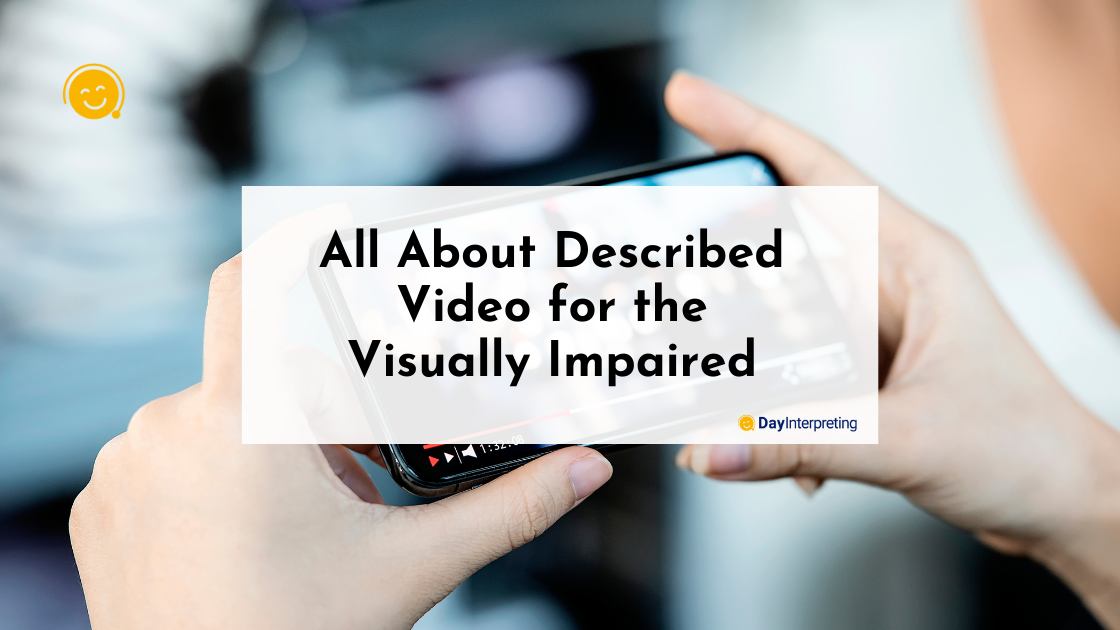Everyone deserves to enjoy a good movie. Have you ever stopped to consider what it’s like for someone who is visually impaired to enjoy a movie? Yep, we’re talking about the described video! It’s not usually something that’s at the front of your mind. But video accessibility is something that enables so many people who are visually impaired to enjoy their favorite programs on TV.
If you’ve read this far, it means that by now you’re wondering what Described Video is and also want to know more about it. Well, that’s where our Day Interpreting Blog comes in. Keep reading to find out all you need to know about Described Video (on-screen text) for the visually impaired.
What is Described Video or an Audio Description Project?
Described Video, also known as Descriptive Video or Audio Description is a service that is carefully curated for those who are blind or have any other form of visual impairment.
It’s important to note that the term Described Video is an official Canadian Term for this type of service. On the other hand, in the United States and the United Kingdom video description is more popularly known as Audio Description.
Whether you know it as video description, a captioned media program, on-screen text, audio narrated descriptions, or Audio Description, it plays a crucial role in providing video accessibility for those who need it most.
What Exactly is in the Description?
When it comes to audio descriptions, the focus is always on the essential aspects of the video so that the listener is able to understand the plot. Video description allows the viewer to see how it’s developing as well as all the character profiles. Therefore, elements such as who is on screen, who is speaking as well as what the setting and scene of the video are are all essential.
The video description goes even further and can describe any type of entrance and exit (by people in the video), how a particular scene is furnished, the lighting, what each person is wearing, their facial expressions, mannerisms, and gestures, and if there is a fight if people are laughing and so much more.
The video description within the video should never be misleading or hard to understand. Your listener is relying on you to effectively consume the content.
Audio Description and descriptive video services always complement and enhance the listener’s experience so they can understand and follow along.
Audio Description or video description is usually inserted where there are notable pauses within a video clip. The quality standards that are associated with Audio Descriptions are important and anyone providing this service should be aware of what they are.
It’s Required by Law
Legal requirements are always being reviewed and or put into place to ensure that accessibility is available for everyone. With this in mind, video descriptions and extended Audio Descriptions are required by law. This applies to television programs and a range of other entertainment media.
Audio Description requirements are embedded into the same accessibility laws as those for closed captioning (for example). Within the Rehabilitation Act of 2018, section 508 refresh states that “all government organizations are legally required to provide audio description, even without an accommodation request”.
This simply means that all modern communications technologies should be accessible to everyone whether or not they have vision or hearing loss.
Facts About Described Video
Just in case you were wondering, Described Video and extended Audio Descriptions is not subtitling or closed captioning.
As long as you’re providing any form of audio-visual content, it is best to incorporate described video. To do this, you can seek out the services of a professional who is familiar with all the working practices for Audio Description.
Here are some important points that you need to note regarding audio description:
It Must Be Clear and Concise
- Audio Description should always be written in a simple, clear, and concise manner that is easy to understand.
- Complete sentences should always be used. This means that the vocabulary should match the content.
- Keep the use of technical terms to a minimum. They should only be used if it is absolutely necessary.
- Avoid using terms such as ‘we see’. It may come off as being offensive. Visual impairment cues the need for audio description.
- There are various opportunities for adding audio description sections to visual elements. Examples of opportunities where these services can be used include the caption file section of YouTube videos, tv programs, and training videos.
It Should be Available at Entertainment Venues
- Descriptive audio of visual elements should be available in places such as movie theaters, museums, sporting events, and theme parks as well as performing arts events such as plays.
- When providing access to DV, it should be free of charge to the person who is requesting it. However, a deposit can be charged for the DV device just to make sure that some form of security is in place in case the device gets stolen or damaged.
- There is a standard logo in the United States to show that Audio Description is available. This logo is to be placed next to movies as well as event titles that offer this as an option to improve the service. The logo consists of a capital A and D along with 3 right-facing parentheses that follow. Therefore the symbol looks like this: AD))).
Examples of Video Description/ Audio Description
When it comes to an audio description project, using simple and easy-to-understand narratives is key. Here are some examples of how narratives for an audio description project should sound:
- Jayne enters a room with blue walls. Clutter is all over the floor. Jayne walks a few steps without noticing that there’s a backpack in front of her. Jayne trips over the backpack and falls down all while using her hand to break her fall and leaving a mark on it.
The painting on the wall features shades of bright green and red, with a blue dot in the center. - Player number 10 hits the ball out of the park
- The rollercoaster ride moves forward as everyone enters a dark room filled with smoke. At this same moment, flashes of lightning illuminate the sky.
Let’s Wrap Up Audio Description Services
As our world becomes more technology-oriented, making goods, products, and services accessible to all should be at the forefront always. Everyone is entitled to enjoy everything this world has to offer despite any form of limitation he or she may have. And things like video accessibility and accessible audio tracks are on the top of the agenda for many production companies and their visual content. Luckily, audio descriptions complement a program’s visual elements and relevant visual information.
At Day Interpreting we believe in visual content accessibility for all which is why we have a team who works to serve you 24/7, 365 days of the year. We also offer the best quality audio description services. Visit our website or download the Day Interpreting app to get started.





0 Comments